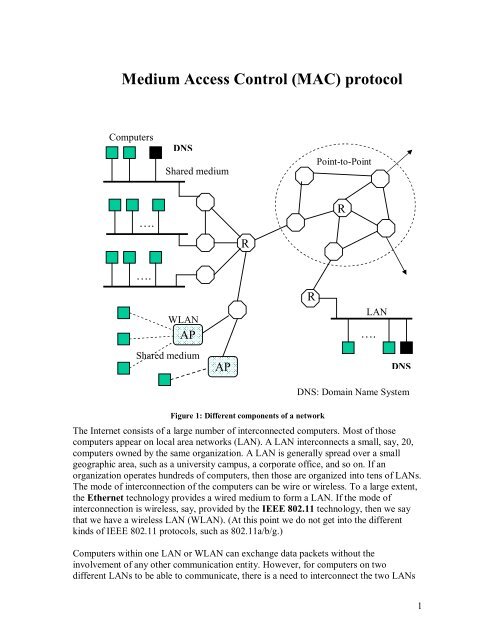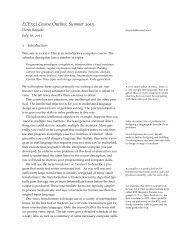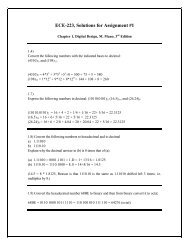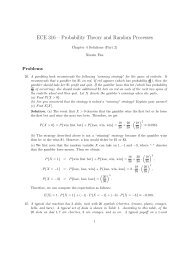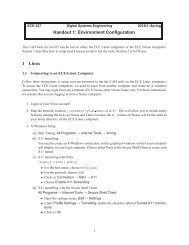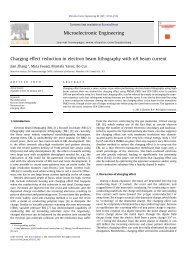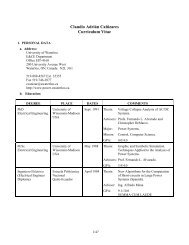LAN - Electrical and Computer Engineering
LAN - Electrical and Computer Engineering
LAN - Electrical and Computer Engineering
You also want an ePaper? Increase the reach of your titles
YUMPU automatically turns print PDFs into web optimized ePapers that Google loves.
Medium Access Control (MAC) protocol<br />
<strong>Computer</strong>s<br />
DNS<br />
Shared medium<br />
Point-to-Point<br />
….<br />
R<br />
R<br />
….<br />
W<strong>LAN</strong><br />
AP<br />
R<br />
<strong>LAN</strong><br />
….<br />
Shared medium<br />
AP<br />
DNS<br />
DNS: Domain Name System<br />
Figure 1: Different components of a network<br />
The Internet consists of a large number of interconnected computers. Most of those<br />
computers appear on local area networks (<strong>LAN</strong>). A <strong>LAN</strong> interconnects a small, say, 20,<br />
computers owned by the same organization. A <strong>LAN</strong> is generally spread over a small<br />
geographic area, such as a university campus, a corporate office, <strong>and</strong> so on. If an<br />
organization operates hundreds of computers, then those are organized into tens of <strong>LAN</strong>s.<br />
The mode of interconnection of the computers can be wire or wireless. To a large extent,<br />
the Ethernet technology provides a wired medium to form a <strong>LAN</strong>. If the mode of<br />
interconnection is wireless, say, provided by the IEEE 802.11 technology, then we say<br />
that we have a wireless <strong>LAN</strong> (W<strong>LAN</strong>). (At this point we do not get into the different<br />
kinds of IEEE 802.11 protocols, such as 802.11a/b/g.)<br />
<strong>Computer</strong>s within one <strong>LAN</strong> or W<strong>LAN</strong> can exchange data packets without the<br />
involvement of any other communication entity. However, for computers on two<br />
different <strong>LAN</strong>s to be able to communicate, there is a need to interconnect the two <strong>LAN</strong>s<br />
1
using a communication entity called a router. Thus, each <strong>and</strong> every <strong>LAN</strong> or W<strong>LAN</strong> is<br />
connected to a router. An organization can own several <strong>LAN</strong>s <strong>and</strong> WANs <strong>and</strong> hence<br />
several routers as shown in Figure 1.<br />
The routers owned by an organization are interconnected so that the different <strong>LAN</strong>s can<br />
work together. Finally, a small number, say one or two, of routers owned by an<br />
organization are connected with external routers for Internet access. In this manner, all<br />
the computers of the world can be, or, in fact, have been, interconnected. This situation<br />
has been depicted in smaller scale in Figure 1.<br />
Medium Access Control (MAC) protocol<br />
<strong>Computer</strong>s <strong>and</strong> routers are interconnected in a wired or wireless manner. In an Ethernet<br />
<strong>LAN</strong>, computers <strong>and</strong> the router are interconnected by a shared medium—the Ethernet.<br />
Thus, all the computers <strong>and</strong> the router need to compete to be able to transmit a data<br />
packet between two computers or between a computer <strong>and</strong> the router. (On the other h<strong>and</strong>,<br />
two routers connected by a dedicated medium, say, a fiber link, do not compete to<br />
transmit data, because the medium is dedicated to the pair of routers.)<br />
A shared medium is also called a broadcast channel, multi-access channel, or r<strong>and</strong>om<br />
access channel.<br />
Problem with a shared channel: Assuming that computers are independent entities, how<br />
to determine who gets to use the medium (channel) next when they compete to access the<br />
channel? (If there is a dedicated channel between two computers, the computers can<br />
transmit data at their will.)<br />
The goal of designing a MAC protocol is to resolve the above issue. Before discussing<br />
the design issues of a MAC protocol, it is important to underst<strong>and</strong> FIVE key assumptions<br />
as described below.<br />
1. Station model: The computers are independent. Once a computer generates a<br />
packet for transmission, subsequent packets are queued up for transmission.<br />
2. Single Channel model: A single channel is available for communication. All<br />
stations can transmit on it <strong>and</strong> all can receive from it. Thus, from the hardware<br />
point of view all stations are equivalent.<br />
3. Collision assumption: If two packets are transmitted simultaneously, the resulting<br />
signal is garbled (if the two signals can reach the same point.) This event is called<br />
a collision. In a wired <strong>LAN</strong> we assume that computers can detect collisions. In a<br />
W<strong>LAN</strong>, it is not possible for a transmitter to detect collision at a receiver.<br />
4. Time model:<br />
a. Continuous: Packet transmission can begin at any instant.<br />
b. Slotted: Packets are transmitted at well-known instants identified by<br />
slots.<br />
5. Carrier sense:<br />
2
a. Carrier sense: Each computer monitors the channel for carrier to know if<br />
the channel is in use.<br />
b. No carrier sense: <strong>Computer</strong>s do not sense the channel before trying to use<br />
it.<br />
We will study a variety of MAC protocols in the class including (pure) Aloha, slotted<br />
Aloha, CSMA/CD, <strong>and</strong> CSMA/CA.<br />
Aloha protocol<br />
In the 1970s, the Aloha protocols were developed at the University of Hawaii to<br />
interconnect computer terminals with the main computers. Each terminal was equipped<br />
with a radio interface as were the main computers. Thus, all the terminals belonging to a<br />
main computer were connected to the computer via a shared medium—the air interface.<br />
There are types of Aloha protocols: pure (unslotted) Aloha <strong>and</strong> slotted Aloha. In the pure<br />
Aloha protocol, terminals can transmit at any time instant, whereas in slotted Aloha,<br />
terminals can transmit at the beginning of well defined time slots.<br />
Pure Aloha protocol<br />
- A terminal can transmit a packet at any instant.<br />
- If the terminal does not receive an ACK before a timeout, it runs a backoff<br />
algorithm. At the end of the backoff period, retransmit the packet.<br />
- If the terminal receives an ACK before a timeout, it is ready to transmit the<br />
next packet.<br />
Note<br />
Slotted Aloha<br />
- If the total traffic is low, the protocol works well.<br />
- If the total traffic is high, the protocol performance is poor. In fact, it is 18%.<br />
(Throughput: Total packet arrival rate * Probability of success of a packet.)<br />
- Packet transmission continues even when there is collision. Loss of<br />
b<strong>and</strong>width.<br />
- The protocol is very simple. It is not used for forming computer networks, but<br />
is used by cell phones in the GSM system to communicate with base stations<br />
of their presence when you switch on a cell phone.<br />
This protocol is similar to the pure Aloha protocol except for the fact that time is assumed<br />
to be slotted. Terminals transmit packets at the beginning of slots, <strong>and</strong> not whenever they<br />
want to. This improved the throughput of the protocol to 37%.<br />
3
CSMA/CD Protocol<br />
To improve the performance of the Aloha protocols, it is important to abort all<br />
transmissions as soon as a collision is detected. This is because once two packets start<br />
colliding, it is useless to continue with their transmissions as both the packets will be<br />
received by their respective receivers with bit errors in them. Such continued<br />
transmissions after a collision will lead to a waste of b<strong>and</strong>width. Thus, there is a need to<br />
detect collision while transmitting a packet.<br />
It is important for a sender to detect collision at a receiver, because it is collision at the<br />
receiver that results in the loss of a packet. However, it is not possible for a sender to<br />
detect collision at a receiver, because senders <strong>and</strong> receivers are located far apart <strong>and</strong> there<br />
is no other protocol more basic than a MAC protocol so that a receiver can inform the<br />
sender of a collision. Thus, a sender makes an assumption <strong>and</strong> uses some other means to<br />
detect a collision at a receiver: (i) We assume that signal from any computer can reach all<br />
other computers. (ii) Collision is detected a little while later than its occurrence.<br />
Start:<br />
i = 0<br />
Wait<br />
T B = R*Tp<br />
R = R<strong>and</strong>om(0,2 i -1)<br />
i ><br />
Kmax<br />
Error<br />
No<br />
Yes<br />
i++<br />
Collision<br />
Send jamming<br />
Signal +<br />
Abort<br />
Sense medium<br />
N<br />
Busy<br />
Y<br />
Transmit frame<br />
WHILE detecting<br />
collsion<br />
Wait<br />
Succes<br />
Figure 2: Non-Persistent CSMA/CD<br />
4
In case of the Ethernet technology, where computers are wired to form a <strong>LAN</strong>, a sender<br />
detects collision by switching on its receiver while transmitting—if what it receives is<br />
different from what it is transmitting, a collision is said to have occurred. It is assumed<br />
that the difference between what a computer transmits <strong>and</strong> what it receives is caused due<br />
to another computer transmitting a packet at the same time.<br />
A MAC protocol with carrier-sensing <strong>and</strong> collision detection is given in Figure 2. The<br />
protocol waits for a while before accessing the medium if the medium is found to be<br />
busy, <strong>and</strong> this is done multiple times for the same packet. Hence, the protocol is known<br />
as Carrier Sense Multiple Access with Collision Detection (CSMA/CD). As the name of<br />
the protocol suggests, the CSMA/CD protocol senses the medium to find out whether or<br />
not it is free before transmitting a packet. If the medium is found to be busy, the<br />
computer waits for a small r<strong>and</strong>om period before sensing the medium once again – this is<br />
known as “non-persistent” carrier sensing.<br />
If carrier sensing indicates that the medium is free, the computer initiates packet<br />
transmission <strong>and</strong> starts detecting collision at the same time. A computer achieves this by<br />
switching on its receiver while transmitting a packet. Collision detection is done by the<br />
physical (PHY) layer. If no collision is detected while a packet is being transmitted, the<br />
packet transmission is said to be successful.<br />
If there is a collision, the computer aborts the transmission process so as not to waste<br />
b<strong>and</strong>width, <strong>and</strong> transmits a jamming signal so that all other computers are aware of the<br />
collision. Next, the computer runs a backoff procedure to hold itself back for a while<br />
from carrier sensing. The duration of backoff is r<strong>and</strong>om, <strong>and</strong> it falls in the range T P [0, 2 i -<br />
1], where T P is propagation time <strong>and</strong> i is a variable denoting how many times the protocol<br />
has gone around the backoff loop before. The reader may note that the range of the<br />
r<strong>and</strong>om number increases exponentially as the medium is found busy in successive<br />
iterations of the loop.<br />
At this point, it is interesting to compute the time a computer may take to detect collision<br />
after starting a transmission. Assume that there are two computers A <strong>and</strong> B separated by<br />
the maximum possible distance d max . Let A sense the medium to be free at time instant t 0 ,<br />
<strong>and</strong> start transmitting immediately. It takes a while for A’s signal to reach B. Assume that<br />
B detects the medium to be free right before A’s signal reaches B, <strong>and</strong> starts transmitting<br />
its packet immediately. B will detect a collision almost immediately. However, for A to<br />
detect collision, B’s signal must reach A. Let t prop be the time taken by signal to travel<br />
between the distance d max between A <strong>and</strong> B. Thus, for A to detect a collision in the above<br />
case, it will take 2*t prop time units. This is because, it will take t prop time unit for A’s<br />
signal to reach B during which B sees the medium to be free <strong>and</strong> another t prop time unit<br />
for B’s signal to travel to A. Thus, A can continue transmitting for 2*t prop time units<br />
before it can detect a collision.<br />
5
For a certain value of d max , for example, 100 meters, <strong>and</strong> given that signal travels at 2/3<br />
the speed of light in free-space (the speed of light in free-space is 3*10 8 meters/second)<br />
on the physical medium, one can easily calculate the value of 2*t prop.<br />
Physical interconnection of computers using Ethernet technology<br />
In the 1970s, wired <strong>LAN</strong>s were constructed using co-axial cables as shown in Figure 3.<br />
Taps at different points on a cable were used to access the medium. To be able to connect<br />
a tap, it was necessary to drive a hole in the cable or cut it at that point to form a T-<br />
junction. One computer is connected to the cable at one T-junction, <strong>and</strong> several T-<br />
junctions had to be formed to connect more computers. Cable installation <strong>and</strong> adding<br />
more T-junctions were the central problems in managing a co-axial cable based <strong>LAN</strong>.<br />
Also, locating cable fault was a major concern.<br />
Co-axial cable<br />
To computer<br />
T-junction<br />
Figure 3: Co-axial cable interconnection in Ethernet technology<br />
Thus, a new technology was invented to eliminate the need for co-axial cables in wired<br />
<strong>LAN</strong>s, as shown in Figure 4. Here, the physical medium consists of an electrical box <strong>and</strong><br />
a set of twisted pairs of cables connected to the electrical box. The task of the box is to<br />
distribute the signal coming in from one pair to all the pairs. It is much easier to install<br />
twisted pairs. Thus, a <strong>LAN</strong> constructed this way is cheaper to construct <strong>and</strong> maintain.<br />
Hub<br />
Twisted pair<br />
C<br />
C<br />
C<br />
C<br />
C: <strong>Computer</strong><br />
Figure 4: Twisted pair interconnection in Ethernet technology<br />
6


